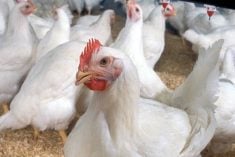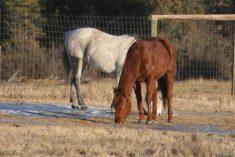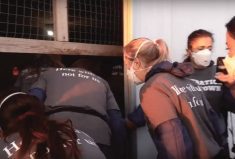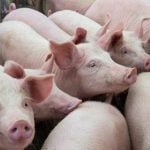Do Canadians want cage-free eggs? Survey says yes. But the data says they’re not voting with their wallets.
In a survey of more than 1,000 Canadians, 72 per cent of respondents said Canada’s code of practice should ban caged confinement of laying hens.
The survey, released this summer, comes from Bryant Research, a U.K. firm that “uses social science research to help accelerate the protein transition from conventional meat to alternative proteins,” its website says.
Read Also

Five new CWD cases confirmed in Manitoba
Chronic wasting disease (CWD) has been found in five more Manitoba deer, including in two new municipalities without previous cases of the disease.
The firm spoke with consumers representing regions across Canada, 97 per cent of whom said they ate eggs. After showing them photos and descriptions of various laying hen housing systems, it asked if they found them acceptable.
Eighty per cent said conventional cages were unacceptable, and 75 per cent said enriched or colony cages were unacceptable.
VIDEO: Grand opening for Manitoba Egg Farmers’ centre
“Given the widespread support for ending cage confinement, many Canadians may be shocked to learn that most major grocery stores still source the majority of their eggs from cage systems,” said animal advocacy group Mercy for Animals in a news release regarding the poll.
“Deadlines for many companies to meet public promises to be 100 per cent cage-free are only two years away,” the group added.
Many large Canadian retailers and restaurant chains have pledged to switch to cage-free eggs. In 2015, McDonalds Canada announced it would phase out eggs from caged birds by 2025. In 2016, several major grocers such as Loblaw, Sobeys and Walmart Canada promised to do the same.
However, some of those companies — while not walking back their commitment — have acknowledged it won’t be possible as soon as promised.
“We’ve learned that the supply chain needs more time to adapt and change,” Sobeys said in its 2022 animal welfare statement.
In its 2022 environmental social governance report, Loblaw said it had made progress toward the goal.
“However, in 2021 it became evident that our farmer partners would not be able to meet the 2025 timeline,” it said. “[We] reaffirmed our commitment to the National Farm Animal Care Council (NFACC) and their efforts to generate consensus around egg systems moving forward.”
The most current guidelines from the council, which develops codes of practices for farm animal care, require conventional battery cages to be phased out by 2036 in favour of enriched or colony housing — larger cages with amenities like perches and nesting boxes.

Industry data shows the percentage of laying hens housed in conventional cages has been in steady decline, falling to 51 per cent in 2022 from 82 per cent in 2016. In 2022, nearly 32 per cent of hens lived in enriched colony housing.
In that time frame, demand for cage-free eggs has grown, but not to anywhere near the majority.
By 2022 the number of hens in uncaged housing like free range, free run or organic systems rose to about 17 per cent from 10 per cent in 2016.
In Manitoba, about 15 per cent of egg quota was devoted to cage-free housing systems in 2022. This was enough to cover demand for free-run, free-range and organic eggs in the province, a spokesperson for Manitoba Egg Farmers told the Co-operator.
“As the market demand for cage-free eggs increases, farmers will ensure there is enough eggs from cage-free housing systems to supply the market,” the spokesperson added.
However, Bryant’s research indicates many Canadians don’t know how their eggs are produced.
When asked “what percentage of egg-laying hens do you think are still housed in cages in Canada,” 43 said they thought half to three-quarters were housed in cages, and 33 per cent said one quarter to half of hens were housed in cages. Thirteen per cent thought zero to one quarter lived in cages.
When shown pictures of conventional cages, nearly 70 per cent of respondents said conditions were worse than expected.
Of those surveyed, 83 per cent said they were more likely to buy cage-free eggs after seeing the images in the survey. Only 63 per cent said they’d be willing to buy cage-free eggs if they cost more, while 25 per cent were unsure and 11 per cent said they would not.
California’s Proposition 12, recently upheld by the U.S. Supreme Court, banned caged housing for laying hens as of 2022. It also banned the sale in California of eggs from hens housed in ways that do not comply with the state’s rules.
In June 2021, the European Commission said it would propose legislation in 2023 to phase out “caged farming” for most animals, Reuters reported. Battery cages are already outlawed, but as of 2019, about half of laying hens were kept in larger, “furnished” cages, Reuters added.
Animal welfare group representatives would have preferred the NFACC do the same, said Kathy Duncan, director of national programs at Humane Canada. Humane Canada representatives often take part in NFACC revisions.
However, enriched housing is an improvement over conventional housing, said Duncan. Typically, conversations around code revisions require compromises — for example, what the industry thinks it can manage in the required timeframe.
“We thought that [enriched housing] should be framed as a transitional form of housing on the way to cage-free rather than a stopping place,” Duncan added.
















